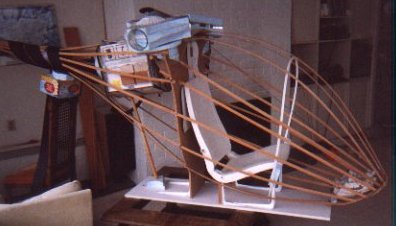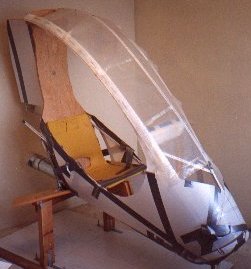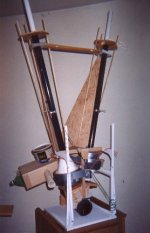
The Unicopter


The worlds only unsymmetrical vehicle is the single rotor helicopter, with its tail-rotor. I believe that this adherence to the tail-rotor has inhibited progress in VTOL craft. Symmetry in both animals and vehicles is beautiful, and this beauty is due to its natural functionality. Germany, during WW II, was the strongest proponent of symmetrical helicopters. Its side-by-side Focke Fa-61 and intermeshing Flettner FL-282 are without equal. After the war, the Germans were in no position to develop and promote their laterally symmetrical helicopters.
The SynchroLite project is directed at the US FAA Part 103 ultralight category, where the maximum dry weight is 254 lbs. The intermeshing rotors and their symmetrical handling result in a craft that has a low power to weight ratio and more importantly is easier to fly then 'conventional' helicopters. This is critical, since the ultralight category does not demand a pilots license.
The UniCopter project is a move toward optimal VTOL, by overcome many of the problems that have beset rotorcraft since their inception. Many of its features have be used before, but never unified in one craft.
The following is a listing of its primary features, and the reason for them;
![]() Symmetrical Rotor Configuration: Two counter-rotating intermeshing rotors eliminate the need for a tail rotor. This symmetry reduces the demands on the pilot in coordinating the cyclic, collective and pedals. In addition, it results in a power to weight ration that is approximately 15% better than the single rotor.
Symmetrical Rotor Configuration: Two counter-rotating intermeshing rotors eliminate the need for a tail rotor. This symmetry reduces the demands on the pilot in coordinating the cyclic, collective and pedals. In addition, it results in a power to weight ration that is approximately 15% better than the single rotor.
![]() Absolutely Rigid Rotors [ARR]: Consisting of: Totally rigid blades. No flapping, no lead-lag and no cone or pre-cone angle. Rigid coupling between rotor hubs and semi rigid coupling to fuselage.This minimizes the pilot's off-axis compensation, caused by cross-coupling. As well, it results in rapid and positive responses to the pilot's control inputs.
Absolutely Rigid Rotors [ARR]: Consisting of: Totally rigid blades. No flapping, no lead-lag and no cone or pre-cone angle. Rigid coupling between rotor hubs and semi rigid coupling to fuselage.This minimizes the pilot's off-axis compensation, caused by cross-coupling. As well, it results in rapid and positive responses to the pilot's control inputs.
![]() Safety: The addition of a rotor governor will reduce the pilot's workload and eliminate low rotor speed. A rotor governor (not an engine governor) provides automatic entry into autorotation.
Safety: The addition of a rotor governor will reduce the pilot's workload and eliminate low rotor speed. A rotor governor (not an engine governor) provides automatic entry into autorotation.
![]() Less Rotor Induced Vibration: The intent is to incorporate leading and trailing edge sealed tabs on the blades to provide high rate pitch change.
Less Rotor Induced Vibration: The intent is to incorporate leading and trailing edge sealed tabs on the blades to provide high rate pitch change.
![]() High Speed Flight: The Advancing Blade Concept [ABC] with its low tip speed and rotor rigidity will reduce retreating blade stall and advancing blade compression during high-speed flight. In addition, the pusher prop contributes to the higher speed.
High Speed Flight: The Advancing Blade Concept [ABC] with its low tip speed and rotor rigidity will reduce retreating blade stall and advancing blade compression during high-speed flight. In addition, the pusher prop contributes to the higher speed.
![]() Quiet: The elimination of the tail rotor and the slower rotational speed of the main rotors will result in less noise.
Quiet: The elimination of the tail rotor and the slower rotational speed of the main rotors will result in less noise.
![]() Aerobatics: The extreme rigidity of the rotor system should, theoretically, provide the ability for prolonged inverted flight, should any exhibitionist desired it.
Aerobatics: The extreme rigidity of the rotor system should, theoretically, provide the ability for prolonged inverted flight, should any exhibitionist desired it.
